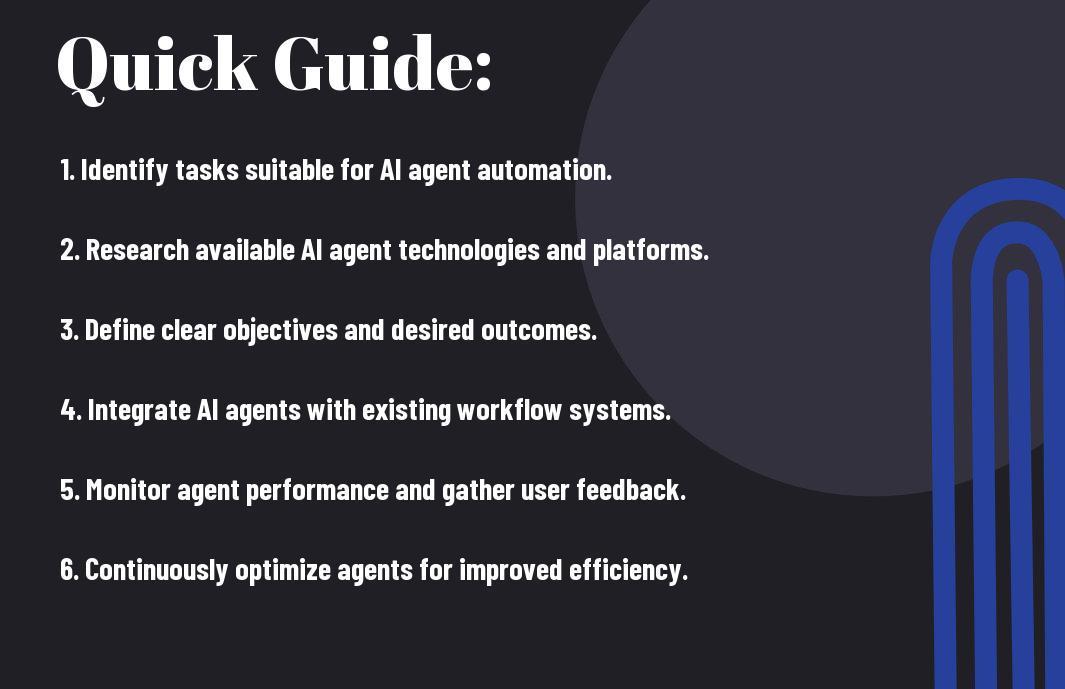There’s a transformative wave in technology, where AI agents are becoming important in streamlining workflows. As you research into this guide, you’ll discover how to implement autonomous solutions that not only boost efficiency but also enhance decision-making processes. With the right strategies, you can leverage AI to tackle mundane tasks while focusing on more strategic projects. Join us as we explore the exciting potential of AI agents and how they can revolutionize your professional landscape.
Key Takeaways:
- Understanding the capabilities and limitations of AI agents is necessary for selecting the right solutions to enhance productivity and efficiency in various workflows.
- Implementing autonomous solutions requires a strategic approach, including thorough planning, integration with existing systems, and ongoing assessment of performance to maximize benefits.
- Collaboration between human workers and AI agents can drive innovation, allowing teams to focus on complex tasks while AI handles routine processes, ultimately leading to improved outcomes.

Decoding the Mechanics of Autonomous Agents
Understanding how autonomous agents operate provides valuable insight into implementing them effectively in your processes. They leverage complex algorithms and data analysis to make decisions without human intervention. By delving into their structure, you discover how to harness their capabilities for productivity and efficiency. For an engaging discussion on related career paths, check out Building AI agents and automation can be a career choice?.
Algorithms That Empower Automation
Algorithms serve as the backbone of autonomous agents, allowing them to process data and make decisions. These mathematical frameworks range from linear regression to complex neural networks, depending on the task at hand. For instance, reinforcement learning algorithms enable agents to enhance their decision-making over time by learning from feedback. This ability to adapt makes them incredibly valuable across various applications, from customer service bots to supply chain optimization.
The Role of Machine Learning in Autonomous Workflows
Machine learning is a key component in the effectiveness of autonomous workflows. By utilizing vast amounts of data, these systems identify patterns and trends, leading to informed decision-making. With ongoing advancements in machine learning techniques, agents can learn continuously, improving their performance with every interaction. For instance, natural language processing allows chatbots to understand and respond to customer queries accurately, transforming user experiences and enhancing satisfaction. As machine learning evolves, the scope for autonomous agents will expand, promising even smarter solutions.

Identifying Key Areas for AI Integration
To effectively implement AI solutions, assess your current workflow and pinpoint specific areas where automation can yield the greatest return on investment. Look for repetitive tasks that consume valuable time, areas with high customer interaction, or processes brimming with data analysis opportunities. By focusing on these key segments, you can enhance efficiency and optimize resource allocation, creating a solid foundation for integrating AI into your operations.
Enhancing Customer Support with Chatbots
Chatbots serve as a valuable asset in customer support, delivering immediate responses and efficient handling of inquiries. By employing AI-driven chatbots, you can ensure that customers receive assistance around the clock, significantly reducing wait times and improving overall satisfaction. These intelligent systems can seamlessly manage common queries, allowing your human agents to focus on more complex issues that require personal attention.
Streamlining Project Management with AI Coordination
AI coordination tools can transform project management by providing real-time insights and automating routine tasks, resulting in enhanced productivity. Incorporating AI helps streamline communication among team members, track project milestones, and allocate resources effectively. You’ll discover that these tools not only minimize the potential for errors but also enable teams to stay aligned and focused on delivering results.
For instance, AI project management platforms like Trello or Asana integrate machine learning algorithms that analyze historical project data to offer predictive analytics. This allows you to anticipate delays and allocate resources more effectively. Imagine having an AI assistant that automatically adjusts timelines based on team performance or shifts in project scope, freeing you to concentrate on strategic decision-making. The combination of these intelligent systems will elevate your project management, driving successful outcomes with less friction.
The Human-AI Collaboration Dynamic
The interplay between human intelligence and artificial intelligence is redefining how we approach workflows. As emphasized in Exploring the Future of Agentic AI in Process Automation, realizing the full potential of AI agents involves understanding their role alongside human team members. When designed thoughtfully, AI can enhance human capabilities, paving the way for innovations that were once unimaginable.
Bridging the Gap: AI as Assistants, Not Replacements
AI technology works best when it serves as a support system rather than a substitute. Leveraging AI’s strengths in data processing and routine tasks allows you to focus your expertise on strategic decisions. For instance, virtual assistants can handle scheduling and client inquiries, ensuring your time is spent on high-impact initiatives. This partnership transforms productivity, leading to healthier collaboration.
Fostering a Culture of Teamwork Between Humans and AI
Creating an environment where humans and AI coexist harmoniously is critical to success. Establishing clear expectations, ongoing training, and open communication fosters effective teamwork. Implementing workshops that illustrate successful AI integration, such as case studies on AI-driven marketing campaigns, enhances your team’s understanding. This proactive approach encourages experimentation and adaptation, positioning your organization to capitalize on emerging technologies and their benefits.
Promoting a culture that embraces AI collaboration not only boosts productivity but also enhances employee morale. When team members see AI as an ally rather than competition, they’re more likely to experiment with AI tools without fear of redundancy. Hosting regular feedback sessions encourages dialogue on AI’s role, resulting in improved processes and more innovative solutions. Your team’s buy-in can turn AI integration into a collective journey, driving your organization forward.
Crafting a Roadmap for Implementation
A well-structured roadmap is vital for integrating AI agents into your workflow, ensuring that you prioritize necessary steps, allocate resources effectively, and monitor progress throughout the process. Initiating with a comprehensive understanding of your objectives, you can develop a timeline and set key performance indicators to assess the impact of AI on your business operations. This blueprint will not only guide your implementation but also facilitate communication among stakeholders and ensure that everyone is aligned towards achieving the desired outcomes.
Steps to Assess Current Workflow Readiness
Evaluating your current workflow is the foundation for a successful AI integration. Begin by mapping out existing processes, identifying bottlenecks, and collecting data on performance metrics. Engage with your team to gather insights on pain points and areas that could benefit from automation. Conducting a readiness assessment allows you to determine the technological infrastructure in place and recognize the skills or resources needed to fully leverage AI agents in your operations.
Strategies for Seamless Integration of AI Agents
Effective integration of AI agents relies on careful planning and execution. Start with pilot projects that allow you to test AI functionalities in real-time environments while minimizing potential disruptions. Incorporate training sessions for staff to ensure they are comfortable using new tools and processes. Establish clear communication channels for feedback, as ongoing adjustments may be necessary to optimize performance. Also, consider leveraging cloud-based platforms for scalability; platforms like Salesforce and Microsoft Azure can simplify integration and provide greater flexibility as your needs evolve.
As you commence on integrating AI agents, keep in mind the necessity of fostering a culture of collaboration and innovation across your workforce. Align AI implementations with your organizational goals by setting up multidisciplinary teams responsible for monitoring progress and adapting strategies as needed. Utilizing data analytics will further empower your decision-making process, helping you to track improvements and identify any necessary adjustments to workflows. Ultimately, positioning your employees as champions of AI technology will ensure that they are engaged and invested in the transformation, driving your organization towards optimal outcomes.
Navigating Ethical Considerations and Challenges
Employing AI agents brings forth a multitude of ethical dilemmas that demand intentional navigation. Addressing these concerns is important to ensure that your autonomous solutions not only enhance productivity but also align with societal values. Striking a balance between innovation and responsibility involves understanding the implications of AI’s decision-making processes and how they impact individuals and communities.
Addressing Data Privacy and Security Concerns
Your AI systems must uphold data privacy and security to maintain trust. With autonomous solutions processing vast amounts of personal and sensitive information, implementing robust data protection measures is non-negotiable. Compliance with regulations, such as GDPR, along with rigorous encryption standards, can help safeguard user data against breaches and misuse.
The Importance of Transparency in AI Decision-Making
Transparency in AI decision-making fosters trust and accountability. When your AI agents operate in a ‘black box,’ stakeholders cannot discern how decisions are made, creating unease and skepticism. By offering insights into the algorithms, data sources, and reasoning behind AI-driven outcomes, you empower users to understand and contest AI-generated recommendations, promoting a more ethical and transparent process.
For instance, a study by the MIT Media Lab highlighted that 74% of consumers would support a company that openly shares the factors driving its AI decisions. Disclosing the methodologies and data used enhances your organization’s credibility and helps users feel more engaged. By establishing clear guidelines for how decisions are made and providing channels for feedback, you cultivate a symbiotic relationship with users, ensuring that your AI initiatives reflect their values and expectations.
Conclusion
The exploration of AI agents offers transformative potential for your workflow, enabling you to implement autonomous solutions that enhance efficiency and productivity. By thoughtfully integrating these technologies, you can streamline processes, reduce repetitive tasks, and improve decision-making capabilities. Embracing this evolution will not only position you at the forefront of innovation but will also empower you to focus on strategic initiatives that drive your success in an increasingly competitive landscape.
FAQ
Q: What are autonomous AI agents, and how can they benefit my workflow?
A: Autonomous AI agents are software programs that utilize artificial intelligence to perform tasks and make decisions without human intervention. They can analyze data, learn from experiences, and adapt to changing environment or requirements. Integrating these agents into your workflow can increase efficiency by automating repetitive tasks, reducing human error, and freeing up time for employees to focus on more strategic activities. For example, they can manage scheduling, customer inquiries, and even data analysis, leading to enhanced productivity and decision-making capabilities.
Q: What steps should I take to implement AI agents in my organization?
A: To implement AI agents effectively, begin with an assessment of your current workflow to identify areas that could benefit from automation. Next, set clear objectives for the AI integration, such as improved efficiency or cost reduction. After that, choose the right AI tools or platforms that align with your goals. It’s important to pilot the technology in a specific department to gather data and insights. Finally, train your team on how to work alongside AI agents, encourage feedback, and continually monitor and adjust the system to ensure it meets your evolving needs.
Q: What challenges might arise when integrating AI agents into my existing systems, and how can I address them?
A: Several challenges can arise during the integration of AI agents, including resistance to change from employees, data compatibility issues, and ensuring the technology aligns with existing processes. To address these challenges, communication is key. Inform your team about the benefits of AI and involve them in the integration process to foster a positive reception. Conduct thorough technology assessments and select tools that can work seamlessly with your current systems. Finally, prioritize ongoing training and support to help employees adapt to the new workflow, ensuring a smoother transition and greater overall success.







